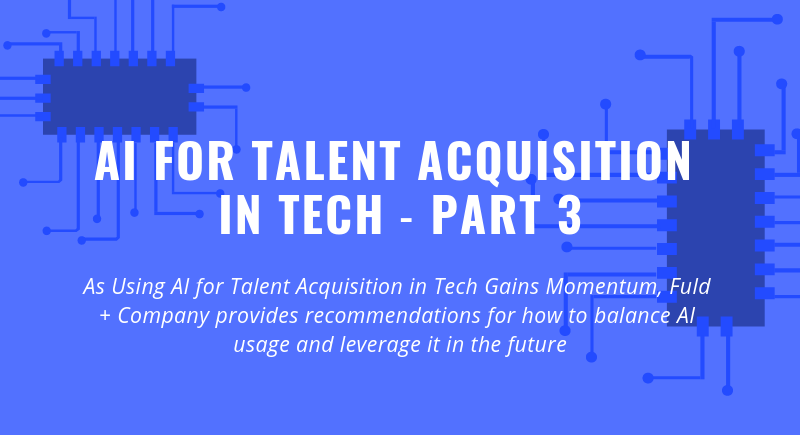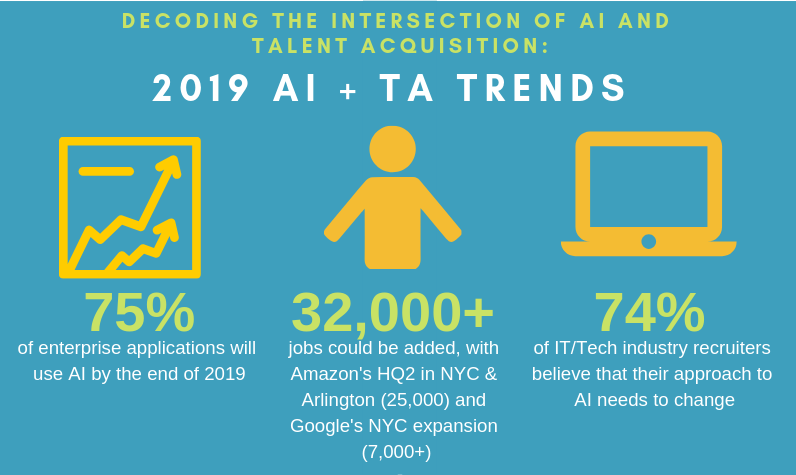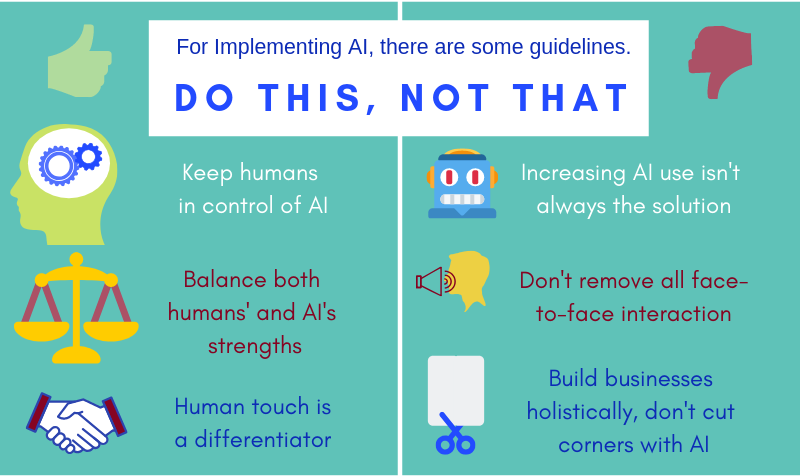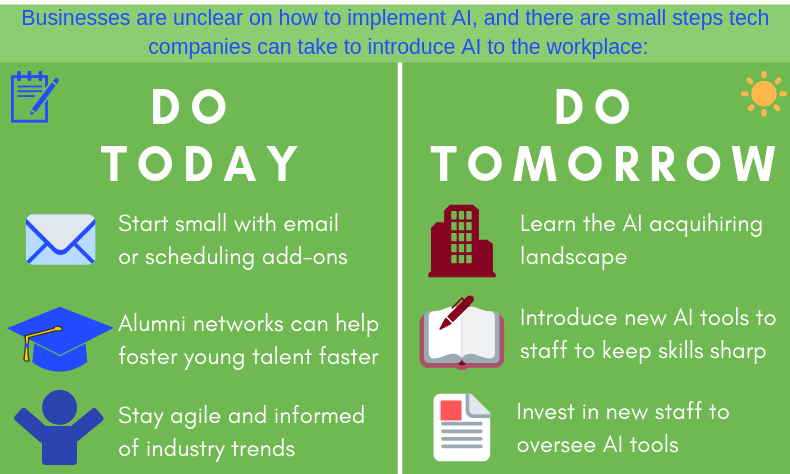AI For Talent Acquisition in Tech – Part 3
Posted by | Fuld & Company

Fuld & Company engages with companies that are seeking confidence in their business strategy, including companies in the technology sector. These companies have increasing interest in dissecting how integrating AI tools can be a differentiator in a competitive environment—especially as AI’s role in the workplace remains ambiguous. When it comes to talent acquisition, it’s clear that AI-led hr tech is both helpful and disruptive across the tech sector, particularly in terms of how it can save time, screen job applicants and analyze existing talent’s capabilities.
In part 1 and part 2 of this series, we discussed potential concerns, misconceptions, and examples of AI tools’ best-applications when it comes to solving a tech talent shortage. As we embark on 2019, it’s certain that AI will remain a prominent topic of discussion in tech, and across other industries. We’ve included a brief summary regarding the role of AI in the workplace and offered advice that depicts how the landscape has shifted in 2018 and explain how a tech company might begin to leverage AI in a balanced way that grows efficiencies without realizing many employees’ greatest fears—being replaced by robots.

A Recap of AI’s Momentum in 2018:
- The IDC estimates that the compound annual growth rate of AI related spending will be ~37% from 2017-2023;
- According to a global survey conducted by CareerBuilder on hiring efforts, 45% of hiring managers surveyed responded that they are unable to fill critical positions because of a scarcity of qualified talent in 2018, we can surmise many of those managers hailed from the technology industry;
- Software developers’ employment is estimated to grow by 24% from 2016-2026, while general computer occupation employment is estimated to grow by 13% from 2016-2026;
- Skilled IT roles are the second hardest to fill, globally;
- Amazon’s HQ2 plans to add 25,000 jobs, with roughly half being tech-based between New York and Arlington; which signifies the need for tech employers to respond to an already increased shortage of talent;
- Google announced that it will be expanding in New York City, adding potentially over 7,000 jobs, further amplifying tech players’ need to attract competitive talent;
- The Manpower Group reports that employers are having the highest level of difficulty acquiring qualified candidates in 12 years (since 2006);
- According to Stack Overflow, 76% of Developers are employed full-time, with an additional 10% retained as an independent contractor/freelancer, or are self-employed at the beginning of 2018;
- 74% of IT/Tech Industry recruiters believe that their method of approaching AI needs to change.

With conflicting information distributed amongst industry circles, it’s best for companies to be educated on how to best use AI. Fuld & Company generated best practices for companies struggling with understanding how to most effectively use AI. Earlier in this series we suggest focusing on introducing AI in moderation, and during scaling; we also advise companies strike a balance between relying on AI tools and human talent for optimum success.
To Achieve Balance, do:
This…
- Keep humans in control of AI tools; do not replace employees with AI;
- Balance the strengths of both AI tools and human capital to ensure optimum hiring outcomes;
- Implement AI incrementally, then add more AI options to the arsenal of tools;
- Keep elements of a “human touch”, which can be viewed a differentiator in a job market where most options are becoming increasingly tech-saturated.
… Not That
- Integrate AI based on its current popularity; use AI is used to accomplish goals;
- Fail to consider the serious trade-offs that stem from letting AI run the show, especially for processes traditionally conducted face-to-face;
- Don’t use AI as a way of cutting corners – holistically improving a business beyond the implementation of digital tools can attract talent in a time when technology is often over-prescribed.

Companies contemplating how to use AI in the workplace as the tech hiring environment becomes more competitive, can take small steps to begin increasing efficiencies and solidifying differentiation.
Actions Companies Should Take Today:
- Learn to use easy AI tools, like email sorting systems and schedulers and ensure that tools are streamlined;
- Communicate with employee alumni networks to gain a competitive edge with fresh talent
- While technology will save time by forming the application process, it’s estimated that over 70% of positions are filled as a result of networking activity
- Stay agile, up-to-date, and informed of industry trends;
- Explore Fuld & Company’s blog on organizational change and understanding how agility influences a company’s ability to compete
Actions Companies Can Put on Hold Until Tomorrow:
- Learn the Acquihiring landscape:
- ‘Acquihiring’ is when a company (often an enterprise) acquires another (often a start-up) for the sake of gaining its talent pool. In 2017, acquisitions of AI-based start-ups had risen by 44% from 2016. While it can bring serious talent to a larger company, start-ups and SMBs should consider if an acquisition is right for furthering their mission or business strategy;
- According to Stanford University, the number of active AI startups has increased by 1,400% since 2000
- Implement a plan that guarantees staff is adequately trained and is up-to-date with tech industry needs. Doing so positively reinforces the existing talent pool;
- Hiring new employees to oversee the management of AI tools can shift the business’ direction. A team dedicated to the continual oversight and integration of AI technology can be considered a differentiator
Key Questions: AI in the Workplace
As players consider what AI’s potential impact will be on their overall strategic vision, it’s important to first evaluate goals for AI’s use and how it helps tech companies measure up in a highly competitive hiring environment. Retaining valuable and resourceful human capital is amongst companies’ greatest concerns, especially as it’s more difficult to operate in a dynamic where giants like Amazon and Google are swallowing prime candidates or recruiting difference- makers and change agents from the “smaller fish.” As companies consider competitive strategies that include AI there are a list of key questions they should ask before embarking on an AI journey:
- How does the company envision AI’s role in its strategic plan?
- What outcomes does management envision as a result of AI’s adoption?
- When should the company be evaluating its AI strategy against that of its peers or competitors?
- Has the company evaluated how AI use can be leveraged to position the company as a differentiator when attracting top tech talent?
- Has the company determined how it’ll evaluate which AI platform(s) are best suited for its specific needs?
AI is a complex topic that many companies are still grappling with and will continue to grapple with as its role in the workplace becomes significantly more crystalized. There are two sides to this equation that need to be considered—how AI is being used for efficiencies, and how the company is developing AI platforms specifically to address its needs. When companies consider each side, they are better positioned to operate in a highly competitive hiring dynamic.

‘AI in the Workplace’ infographic credit: Anne-Marie Downey
Tags: Artificial Intelligence, Change Management, Human Resources, Information Technology, Modern Workplace, Other Industries, The Race for Talent



















